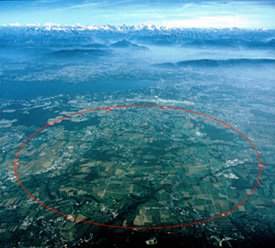Large Hadron Collider Data
 The LHC is being installed in a tunnel 27 km in circumference, buried 50-175 m below ground. It's located between the Jura mountain range in France and Lake Geneva in Switzerland (photo courtsey CERN)
The LHC is being installed in a tunnel 27 km in circumference, buried 50-175 m below ground. It's located between the Jura mountain range in France and Lake Geneva in Switzerland (photo courtsey CERN)The Large Hadron Collider (LHC) is the largest scientific instrument of the world. This latest and very powerful particle accelerator is currently being built by CERN, Geneva and is due to switch on in 2007. The physicists and engineers associated with LHC form the largest ever international collaboration in the history of science.
LHC, in its pursuit of deeper understanding of subatomic matter, will ultimately collide beams of protons at an energy of 14 TeV with accelerated beams of lead nuclei, smashing them together with a collision energy of 1150 TeV. For your comparison, 1 TeV (= 1012eV) is a unit of energy equivalent to about the energy of motion of a flying mosquito. So, the numbers above may not look very 'high' to you, unless we say that the LHC accelerator will squeeze that much energy into a space about a million million times smaller than a mosquito. That's what makes such particle accelerators so special.
The aim of LHC would be to push our understanding of the fundamental structure of the universe. The results from the LHC might shed light on the existence of dark energy or dark matter and extra dimensions (beyond 3 spatial dimensions and 'time' that Einstein taught us to include), Higgs bosons and other elementary particles predicted by Supersymmetry theory.
The two largest physics collaborations at the LHC, CMS (Compact Muon Solenoid) and ATLAS (A Toroidal LHC ApparatuS), each encompass more than 2,000 physicists and engineers from 170 universities and laboratories. In order to fully exploit the potential for scientific discoveries, the many Petabytes (=1012 bytes) of data produced by the experiments will be processed, distributed, and analyzed using a global data Grid. The key to discovery is the analysis phase, where individual physicists and small groups repeatedly access, and sometimes extract and transport, Terabyte-scale data samples on demand, in order to optimally select the rare "signals" of new physics from potentially overwhelming "backgrounds" from already-understood particle interactions. This data will amount to many tens of Petabytes in the early years of LHC operation, rising to the Exabyte (=1018 bytes) range within the coming decade.
In last one year the international team of LHC has achieved some major milestones and set some records in the process of acquiring, storing and transfering such data to research laboratories situated throughout the world. Even before switching on the accelerator and starting physics experiments, the team has already contributed some major breakthroughs in the world of technology.
After all, not very long ago, CERN had given birth to the World Wide Web!
If you are a 'data geek' and get excited by handling, storing and transfering data, you may look at the following postings from our sister website 2Technology:
New Record for Network Data Transfer (Dec 14, 2006)
LHC's New Milestone (Mar 4, 2006)
Fast Network Record (Dec 9, 2005)
Labels: Elementary Particles

0 Comments:
Post a Comment